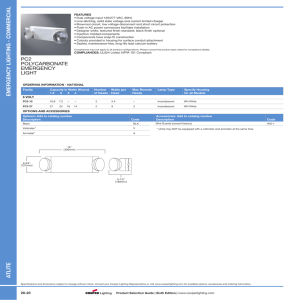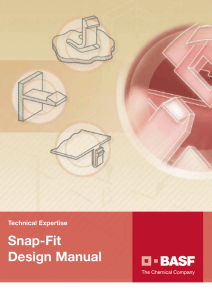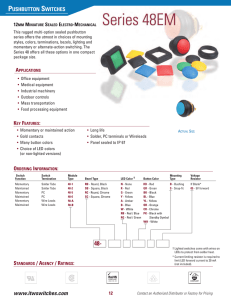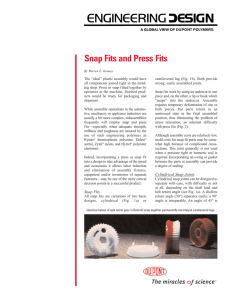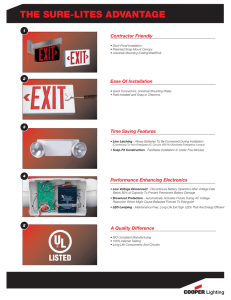here
advertisement
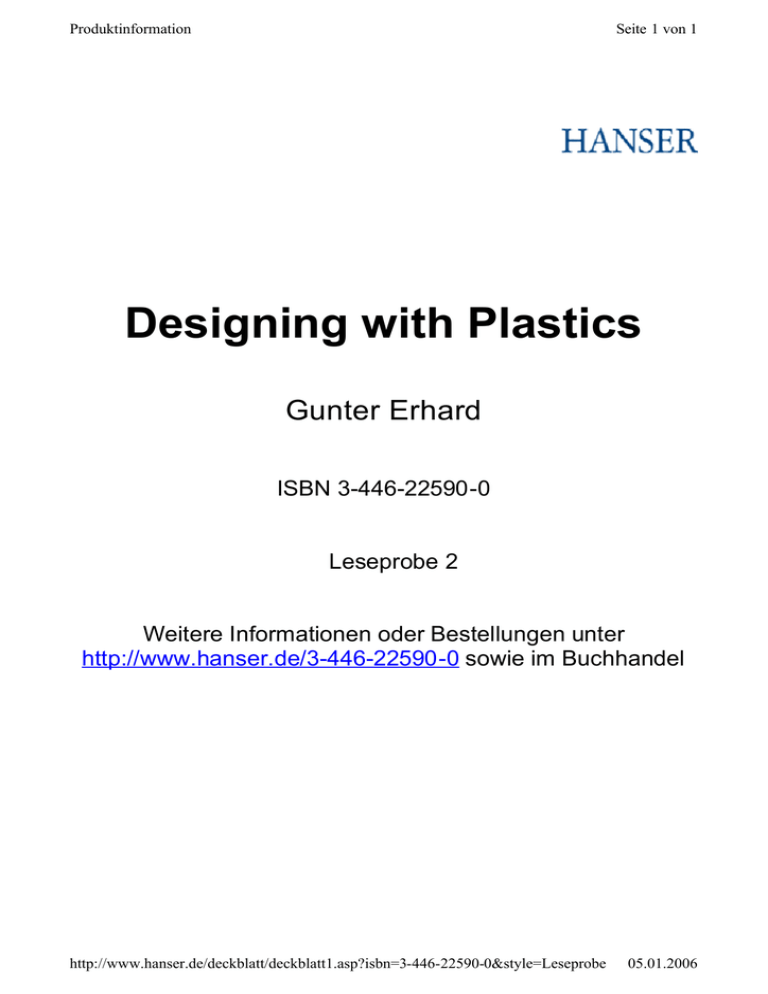
Produktinformation Seite 1 von 1 Designing with Plastics Gunter Erhard ISBN 3-446-22590-0 Leseprobe 2 Weitere Informationen oder Bestellungen unter http://www.hanser.de/3-446-22590-0 sowie im Buchhandel http://www.hanser.de/deckblatt/deckblatt1.asp?isbn=3-446-22590-0&style=Leseprobe 05.01.2006 8 Flexing Elements Structural elements that are required to have high deformability should be designed so that they are capable of withstanding the flexural or torsional loads associated with the application (see also Section 6.1). Two examples of such designs common in parts made from polymeric materials are snap-fit or interlocking joint elements and elastic elements. Another common feature in parts designed for high deformability is their relatively thin wall thickness. For example, integral hinges are structural elements having extremely low wall thicknesses. 8.1 Snap-Fit Joints Definition Joint types are defined according to the mechanisms acting at the points of attachment holding the assembled parts together (see Figure 8.1) [8.1]. On this basis, a snap-fit joint is a frictional, form-fitting joint. The structural features of a snap-fit joint are hooks, knobs, protrusions, or bulges on one of the parts to be joined, which after assembly engage in corresponding depressions (undercuts), detents, or openings in the other part to be joined. Accordingly, the design of a snap-fit joint is highly dependent on the polymeric material(s). Snap-fit joints are also relatively easy to assemble and disassemble. A key feature of snap-fit joints is that the snap-fit elements are integral constituents of the parts to be joined. Figure 8.1 Types of joints (schematic) [8.1] a) Form-fitting joint b) Frictional joint c) Adhesive joint d) Frictional form-fitting joint ←→ Direction of action of forces 312 8 Flexing Elements [References on Page 362] Differentiated and Integrated Construction Design solutions using “differentiated” construction assign certain functions separately to the individual structural elements with the goal of fulfilling all of the functional requirements in an optimum manner. This inevitably means that there are a number of parts in a subassembly. “Integrated” construction, on the other hand, uses fewer parts and consequently results in lower assembly costs but may require the acceptance of restrictions or compromises in functionality. Figure 8.2 shows this trade-off with reference to the example of a bayonet coupling. Figure 8.2 Design variants for a coupling as described in [8.12] and [8.16] The systematic reduction in the numbers of parts finally leads to variant d), a snap-fit joint made from polymeric material. Injection molding technology is so versatile, that it allows for the integration of functions directly into the parts to be joined. Classification Snap-fit joints are classified according to the most varied attributes [8.2, 8.3, 8.4, 8.13]. However, a classification based on geometrical considerations appears to be most appropriate here (see Figure 8.3). Figure 8.3 Classification scheme for snap-fit elements based on geometrical considerations 8.1 Snap-Fit Joints 313 Dimensions and Forces The dimensions and forces associated with assembly/disassembly are discussed in the following figures. Figure 8.4 Dimensions and their designations for snap-fit hooks α1 = Joining angle α2 = Retaining angle b = Breadth of cross section (hook breadth) h = Height of cross section l = Snap-fit length H = Snap-fit height (undercut) Figure 8.5 Dimensions and their designations in cylindrical annular snap-fit joints dmax = Greatest diameter of the snap-fit joint dmin = Smallest diameter do = Outer diameter of the outer part so = Wall thickness di = Inner diameter of the inner part si = Wall thickness } } } Figure 8.7 Dimensions and their designations in torsional snap-fit joints lT = Length of torsion rod rT = Radius β = Torsion angle γ = Twisting angle l1,2 = Lever arm lengths f1,2 = Elastic excursions Q1,2 = Deflection forces } Figure 8.6 Dimensions and their designations in spherical annular snap-fit joints 314 8 Flexing Elements " FF [References on Page 362] Figure 8.8 Angles and forces at the active surface Q = Deflection force F = Assembly force FN = Normal force FF = Friction force Fres = Resultant force α1 = Joining angle (lead-in angle) ρ = Friction angle The forces and angles at the assembly contact surfaces of the joints (see Figure 8.8) apply in an analogous manner for all snap-fit joint design variations. Assembly Operation A review of the snap-fit assembly operation is helpful to gain a better understanding of the factors at work and of the calculations discussed below. The assembly force F, generally acting in the axial direction, is resolved at the mating surface in accordance with the mathematical relationships associated with a wedge (see Figure 8.8). The transverse force Q causes the deflection needed for assembling the joint. At the same time, friction and the joining angle determine the conversion factor η. η = tan(α1 + ρ) = f + tan α1 1 − f ⋅ tan α1 (8.1) The relationship in Eq. 8.1 is plotted in Figure 8.9 against α1,2 for common values of η. The retaining or release force of the joint can be altered using the retaining angle α2. The use of a value of α2 ≥ 90° creates a self-locking geometric form-fitting joint. Figure 8.10 illustrates that a joint constructed in this way can be released again without forced failure of the joint when the moment of the force couple represented by the retaining and reaction forces is able to overcome the friction force in the active surface. A design countermeasure to prevent release in this way is to attach a retaining guard or locking ring (see also Sections 8.1.1.3 and 8.1.3.3). As snap-fit features are being assembled, the assembly force follows the characteristic pattern shown in Figure 8.11. This is also described in [8.11] and [8.23]. After a steep rise, the assembly force reaches a peak, falls to a lower level where it remains fairly constant as the lead angle causes the part to deform, and then falls back to zero, once the joint area of the part snaps into place. Deformation during the assembly of snap-fit joints can be significant. As a result of these deformations during the assembly operation, the geometric relationships change (e.g., the relative angular positions) [8.21, 8.10]. This, however, is not taken into account in the calculation of the assembly forces in the sections below. The local variation of the plane of action and its effect on transverse force during the assembly operation is likewise not taken into account (see Section 5.4). 8.1 Snap-Fit Joints 315 Figure 8.9 Conversion factor η for various coefficients of friction f as a function of the joining (lead-in) angle or the retaining (snap-out) angle [8.11] Figure 8.10 Forces and moments acting on a snap-fit hook having a retaining angle of 90° at the time of release 316 8 Flexing Elements [References on Page 362] Figure 8.11 Assembly force over the assembly path for cylindrical snap-fit joints having different size undercuts. Outside part is made of POM (H 2200) with dmin = 40 mm; inside part is made of steel [8.18]. Loss of Retaining Force In the case of snap-fit elements that are repeatedly joined and separated, or those that remain under a residual stress, the time-dependence of the material properties should be taken into account. In line with viscoelastic behavior, the strain (deformation) imposed during the assembly operation diminishes only gradually. Test results on separated [8.21] and on assembled snap-fit joints made from POM and PP [8.11] have shown that recovery after release of stress can take as long as 4 to 5 hours. The residual strain found in these cases was in the range of 1 to 3% for disassembly strain values of 8 to 10%. These residual strain values are reached asymptotically after 5 to 10 assembly or release cycles. Lower assembly related strains lead to lower residual strains. In addition, after a large number of assembly cycles, no further loss of retaining force is observed. If the snap-fit joint element is deformed enough during assembly resulting in a residual stress, this stress relaxes over time after assembly in line with the relaxation behavior of the material. The residual stress or residual elastic force remaining can be estimated theoretically by linearizing the isochronous stress-strain diagram (see the example calculation in Section 5.3.2). Figure 8.12 Relationship between residual strain and number of release cycles for an annular snap-fit joint made of POM having a rigid inner part for different undercut sizes [8.11] 8.1 Snap-Fit Joints 8.1.1 Snap-Fit Beams 8.1.1.1 Types of Snap-Fit Beams 317 The most common structural element in snap-fit joints is a beam, subject to a bending load, in the form of a cantilever snap-fit beam with a hook. Its useful snap-fit height (momentary interference) can be altered by changing the cross-sectional shape of the beam and, of course, by its effective snap-fit length. Good utilization of material is reflected in high values for the geometry factor C (see Figure 8.13). Figure 8.13 Material utilization as reflected by the geometry factor C in snap-fit hooks having different cross-sectional shapes according to [8.5]. The values of C for the trapezoidal cross section apply to the case in which the tensile stress acts in the wide face of the trapezium. Uniform loading of the material and hence optimum utilization of the material for a cantilever snap beam is achieved by a linear decrease in width or a parabolic decrease in thickness along the length of the beam. 318 8 Flexing Elements [References on Page 362] Figures 8.14 to 8.17 indicate some aspects of importance for production in the design of snapfit hooks. For example, two opposing hooks are more easily produced if they have a cross section in the form of a cylinder segment rather than a rectangular cross section. The simpler production due to the cylindrical shape of the geometric envelope affords substantially lower mold production costs. The production costs for drilling, reaming, and polishing the circular cross section may have a cost ratio of 1 : 4 compared to those for producing a rectangular cross section by spark erosion and milling [8.7]. By skillful partitioning of the snap features within the mold and the use of shut-offs or piercing cores (see Figure 8.15), snap-fit hooks can be produced without complicated mold actions. When shut-offs are used to produce snap-fit beams and hooks, the designer must allow for the shut-off angle (0.5 to 1°). In clamshell housing parts, such as those illustrated in Figure 8.16, the undercuts of built-in hooks are most easily molded if the hook faces outward (top) rather than inward (bottom). The maximum stress that occurs when a beam bends is usually at the transition from the snap-fit beam to the molding. Radii of curvature have to be provided here, even if this increases mold-making costs. Even a radius of 0.5 mm reduces the peak stress at the transition considerably (see Figures 8.17 and 10.4). Generous radius values are also recommended for segmented annular snap-fit joints (Figure 8.17). Adequate snap-fit hook height can be achieved by extending the length of the elastic section of a hook (see Figures 8.18 and 8.19). Interlocking joints with a series of joining positions arranged one behind the other allow for assembly at various positions. Figures 8.19 to 8.21 show examples of this concept applied to molded parts. The concept of an elastic snap-fit beam with a hook and a rigid undercut may also be “reversed” to form the variant of a rigid hook and an elastic beam with an undercut. An example of this is shown in Figure 8.22. Figure 8.23 shows an example of an automobile headlight housing incorporating this concept (see also Figures 8.27 and 7.60). Figure 8.14 Snap-fit hook with circular (a) and rectangular (b) envelope shape and associated details of the injection molds [8.7] 8.1 Snap-Fit Joints 319 Figure 8.15 Principle of demolding a snap-fit beam and hook without special mold action [8.20] Figure 8.16 Beam hooks (undercuts) on the core side (bottom) cause higher mold costs than those facing outward (top) [8.13] Figure 8.17 Rounding-off the segment gap for slotted annular snap-fit joints to reduce peak stress values Figure 8.18 Principle of extending the length of the elastic (bending) section of a snap-fit hook [8.9] Figure 8.19 Interlocking joint with saw tooth profile and retaining guard on a clamping ring 320 8 Flexing Elements [References on Page 362] Figure 8.20 Interlocking joint capable of adjustment [8.2] Figure 8.21 Plug housing capable of being fixed sideways in two locking positions Figure 8.22 Housing cover joint assembled using cantilever beams with undercuts rather than hooks [8.5] Figure 8.23 Joint composed of a rigid hook and an elastic bracket 8.1 Snap-Fit Joints 8.1.1.2 321 Snap-Fit Beam Calculations Permissible Size of Undercut A snap-fit hook (snap-fit bracket) may be simplified as a bending beam fixed at one end (i.e., a cantilever beam). Calculations can be performed on the basis of classical bending theory*. In the assembly calculations, the beam is theoretically deflected by at least the depth of the undercut. In this rough calculation, the effect of shear stress due to the transverse force is usually neglected because l ✱ h. Any deflection of the mating surface is usually estimated or neglected in the classical calculations, although it may be considered in Finite Element Simulations. The permissible size of the undercut (snap-fit height) for a cantilever snap-fit beam can be determined based on the permissible outer fiber strain εperm for the material from which the beam will be made. H perm = C l2 ⋅ ε perm h (8.2) where C = Geometry factor (see Figure 8.13) εperm = Permissible outer fiber strain as an absolute value (m/m) Guide values for one-shot assembly: Semi-crystalline thermoplastics ≈ 0.9 εY Amorphous thermoplastics ≈ 0.7 εY Reinforced thermoplastics ≈ 0.5 εY Guide values for frequent assembly: Strain at σ0.5% (see Figure 5.2c). Snap beams having shapes and cross sections other than those shown in Figure 8.13 cannot usually be analyzed in this way. A method for analysis of beams with more complex cross sections is given in Section 5.4. Assembly Force and Retaining Force The assembly force, F, is calculated from the deflection force Q and the conversion factor η. F =Q⋅η (8.3) where η is obtained from Figure 8.9. The retaining force is calculated by analogy with the retaining (or return) angle α2 (for α2 ≥ 90° see Figure 8.10). During assembly, plastic deformation may occur so that as a result of changed geometry, the actual retaining force may be smaller than the one calculated [8.11]. Even when the retaining and joining angles are the same, the separating force is a little smaller than the assembly force. This can be attributed to the fact that the bending moment between the planes of action of the actuating forces and the plane of action of the reaction force in the material tends to open the snap-fit connection during assembly. * Using classical handbook equations or commercially available computer programs such as the SNAPS PC program from BASF or Fittcalc from Ticona. 322 8 Flexing Elements [References on Page 362] The deflection force is given by Q =W ES ⋅ ε l (8.4) where W = section modulus for a rectangular cross section (I/c) where c = h/z. W = b ⋅ h2 6 for a trapezoidal cross section (with tensile stress in the wider face) W = h2 a2 + 4 a b + b2 ⋅ 12 2b + a for other cross sections see Hütte, Dubbel and other reference works. ES = secant modulus in MPa for the strain arising associated with the deflection ε = strain arising as an absolute value (m/m) 8.1.1.3 Additional Functions Overstrain Safeguards Snap-fit hooks, especially thin fragile ones or those made using brittle materials, must be adequately protected against excessive stress or deflection (see Figures 8.24 and 8.25). Figure 8.24 Overstrain safeguards for snap-fit hooks [8.19] Figure 8.25 Snap-fit hooks can be safeguarded against excessive strain or fracture by means of a deflection limit or stop (Photograph: Siemens AG, Munich) 8.1 Snap-Fit Joints 323 Figure 8.26 Tabs act as retaining guards, guide surfaces, and provide tolerance compensation a) Undercut b) Tab c) Snap-fit beam and hook Retaining Guards In order to prevent inadvertent or unwanted release of a snap-fit joint (see also Figure 8.10) with certainty, the snap-fit hook can be secured after assembly by another element in the structural unit. Figure 8.26 shows one of many possibilities by the example of the base of a coffee machine. The hot plate is inserted into the two parts of the housing where it presses the tab against the snap-fit hook and in this way secures it against release. Additionally, these tabs provide guidance for the assembly of the hot plate and compensate for any tolerance variations. Opening Aids An extension of the snap beam (beyond the hook) in the form of a recessed grip is a simple way to facilitate release of a snap-fit joint by hand (see Figure 8.24). Designs, such as the one shown in Figure 8.27, have also proved to be effective. In this case, however, the bending stress has to be absorbed by the very short fillet between the housing and the actual connecting element. In the locking mechanism shown in Figure 8.28, a spring provides the force required to keep the fulcrum snap-fit in place. In the case of snap-fit opening aids involving tools, appropriate means of access and gripping must be designed into the parts to be assembled (see, e.g., Figure 8.29). Energy Storage Devices Permanent pretensioning is not easily obtained with molded snap-fit connections made of polymeric material due primarily to the limitations of polymeric materials. Therefore, stresses in the joint should be released as much as possible after assembly. When, however, only relatively small amounts of energy are to be stored, e.g., for compensating tolerances or obtaining small prestress, this can be accomplished using pretensioned snap-fit elements made of polymeric materials. Glass-fiber reinforced materials are best for these applications, but unreinforced materials such as POM can also be used (see Figure 8.28). The residual pretensioning can be estimated from the creep modulus Ec (see example calculation in Section 5.3.2). 324 8 Flexing Elements [References on Page 362] Figure 8.27 During assembly, mainly the snap-fit bracket is deformed, while during separation, only the short fillet is deformed Figure 8.28 Locking mechanism for a housing cover (Photograph: Siemens AG, Munich) Figure 8.29 Opening a pipe clamp by means of a screwdriver Seals Reliable sealing of two components joined by snap-fit beams can be achieved only if a sufficient number of snap-fit beams is provided and if the pressure of the elastic seal is accomplished by tensile stress (not bending stress) in the beam (see Figure 8.30). Figure 8.30 Principle for designing an elastic seal
